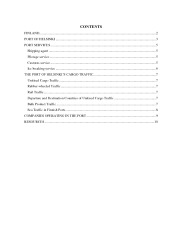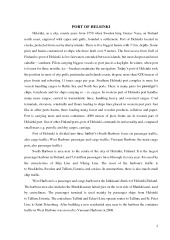Ports Of Finland



Ports of Finland.
The land transport of the port’s cargo traffic was primarily carried out as rubber-wheeled transport. In total, 502,000 trucks, trailers and similar vehicles passed through the port of Helsinki, transporting 6,4 million tonnes of cargo, which amounted to 64% of the port’s total unitised cargo traffic. The number of transport vehicles increased by 4%, and the amount of cargo transported in them increased by 6% compared to the previous year. The most significant cargo flows by volume were the ones to and from Tallinn, Travemünde and Stockholm. The market share of the rubberwheeled traffic of Finnish harbours was 53%, while the market share of goods transported in rubber-wheeled vehicles was 49%. The largest cargo flows were once again transported between Helsinki and German harbours.
Approximately 0,5 million tonnes of cargo was transported to Vuosaari Harbour by rail, which accounts for nearly 10% of all land transport to the harbour.
The cargo traffic was targeted at the harbours of the Baltic Sea and the North Sea. Approximately one-fifth of the goods continue their journey to, or originate from, Europe. This cargo is reshipped to other ships in European container centres in Hamburg, Bremerhaven, Rotterdam, or Antwerp. The largest cargo flows were once again transported between Helsinki and German harbours. The total volume of parcelled goods traffic was 3,7 million tonnes, which accounts for 37% of the port’s unitised cargo traffic. The volume of traffic between Helsinki and Estonia was 3,1 million tonnes, which accounted for 31% of our unitised cargo traffic.
The bulk product traffic totalled 0,8 million tonnes, consisting primarily of coal imported for the needs of the energy company Helsingin Energia. For the most part, bulk cargo was transported as dry bulk with dry cargo carriers or with tankers, chemical tankers or sand yawls.
In 2014, the total volume of Finnish ports’ cargo traffic was 96,1 million tonnes, nearly the same as the previous year. The volume of import traffic was 47,9 million tonnes, a decline of 2%, while the volume of export traffic was 48,2 million tonnes, an increase of 2% compared to the previous year.

















